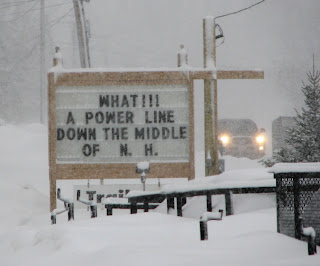I've never heard of anyone who yearned to write the great American scoping comment, but since none of us was born knowing how to write this genre, here's advice from a scoping comment writing coach. Some of the material that follows comes from Elizabeth Mullin's The Art of Commenting: How to Influence Environmental Decisionmaking with Effective Comments (2000). It will also explain how the process works.
Scoping is the process of identifying concerns or issues to be studied by DOE-Normandeau (and its sub contractors) as it prepares the Draft Environmental Impact Statement (DEIS). As Mullins explains, there's actually a draft draft EIS; that will be written by the contractor (Normandeau et al.) after it sorts through and categorizes all of our comments. DOE will go over the draft draft and supervise Normandeau's writing of the DEIS. In other words, Normandeau is our immediate audience as scoping comment writers
You may deliver your comments orally at one (or more) of the five scoping meetings from March 14-19, but be sure also to submit them in writing. You may submit written comments now, before the public meetings, then attend the public meetings and hear what opponents and proponents have to say, and submit additional comments in light of what you hear. If you forget something or a new issue comes up, write another comment and get it in by April 12.
All of the public comment that comes in before April 12 will be inventoried and converted into categories of issues that are lumped together into larger subject areas in the scoping report. The number of commenters who wrote about an issue will be indicated. For instance, the underground/underwater Champlain Hudson Power Express (CHPE) Scoping Report creates a purpose and need category and states that "nine commenters noted that the purpose and need statement should establish the evidence that the need for electricity exists in the area, or will exist if projected population and planned land use growth are realized" (p. 9). (The CHPE "raw data" is here, the recently completed scoping report here.)
For Northern Pass, DOE has stated that it will be looking at these categories:
"Impacts will be analyzed across a number of resource areas, including:
- Air quality (including climate change and greenhouse gas emissions)
- Water resources and drainage
- Geography, geology, and soils
- Land use
- Threatened and endangered species, special status species, and related sensitive resources
- Airspace utilization
- Public health and safety
- Noise
- Natural hazards
- Hazardous materials
- Accidents and intentional destructive acts
- Cultural and historical resources
- Recreational resources
- Visual resources
- Socioeconomic impacts, community services and infrastructure
- Environmental justice considerations (disproportionately high and adverse impacts to minority and low income populations)
- Cumulative impacts (past, present, and reasonably foreseeable future actions)
- Irreversible and irretrievable commitments of resources
Similarly, DOE states that it will consider "alternative routes." They say nothing about "alternative designs," e.g., burying the lines. If this is your concern, request that the DOE consider alternative designs and/or routes. Again, if you don't ask for it, you probably won't see it in the scoping summary report.
The private contractor, Normandeau, not the DOE, will read, inventory, and categorize the raw data of our public comments and prepare this scoping report. This will necessarily be a subjective process. How would you categorize the hypothetical comment that "Northern Pass is an immoral project that will ruin my economic future and scar the landscape"? Most likely, this comment would be categorized under "socioeconomics" and "visual resources." The "immoral" nature of the project would probably slip through the cracks.
To guard against this slippage, the scoping comment coach recommends that writers overtly direct the DOE to examine specific issues broken down into categories. Don't let the contractor decide what the category is; tell the contractor how to categorize your concerns. Once the contractor converts your comment into a statistic for the scoping report, your comment essentially drops out of the process.
Thus, for instance, the comment that "Northern Pass is an immoral project that will ruin my economic future and scar the landscape" should be rewritten to direct the DOE to study your concerns, e.g.,
The DOE should investigate the following issues for the DEIS:
- the immorality of the project, specifically, is it just to impose the burdens of this project on people who stand to gain nothing from it? (or whatever the moral grounds are);
- the negative economic impacts of the project on landowners who will not receive adequate compensation for their property;
- the detrimental impact on landscape, which is essential to tourism here.
Here's another hypothetical comment that doesn't tell the contractor specifically how to classify it and doesn't tell the DOE what to study: "I want to go on record as opposing this project unless the lines are buried."
That might be rewritten to: "The DOE should include an alternate action that examines the feasibility of burying the lines, including an examination of nearby corresponding projects . . .", etc.
One writing coach goes even further and recommends filing a separate comment for each topic:
"Write a separate comment for each topic you cover. The agency issues a Scoping Report which deals with comments by topic or issue. A team will inventory them (by sender). They'll pencil "soils', or 'wildlife' or 'recreation needs' at the top of your comment, and sort them into stacks. If you combine a bunch of issues in one letter, you might hurt your chances that your comments will be inventoried accurately and get
included in the scoping report."
The more common advice is to explicitly request the DOE to look at specific issues, to identify those issues in a way that individualizes them and thus increases the chances that they'll survive intact through the inventory process, to avoid "bundling" and blurring issues, and to write as clearly as possible.
The Sierra Club (Atlantic Chapter) public comment on CHPE provides a good model of how to insure that your concerns and issues survive intact. Another Sierra Club Atlantic committee also models the format in a scoping comment that bears reading because it directs the DOE to examine issues that are germane to the Northern Pass project, e.g., is this project needed?
For advice on issues to address in your scoping comments, see the Conservation Law Foundation's page.
The beauty of the public comment period is that you can go back and rewrite as often as you want before April 12. The comments can be entered online at northernpasseis.us.
Write clearly, write often, and remember that your immediate audience will be Normandeau et al.









